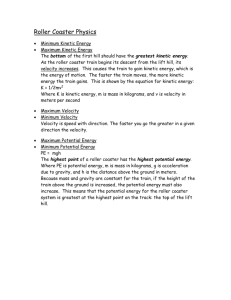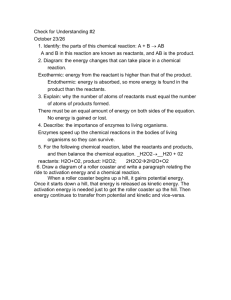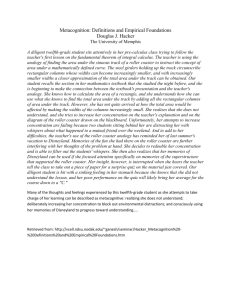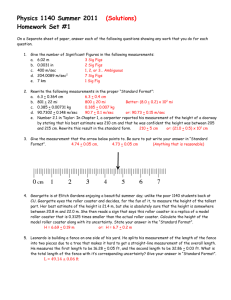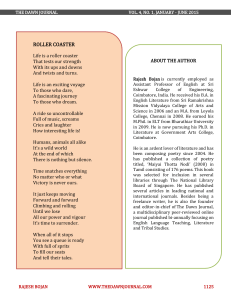Physics of Roller Coasters
advertisement
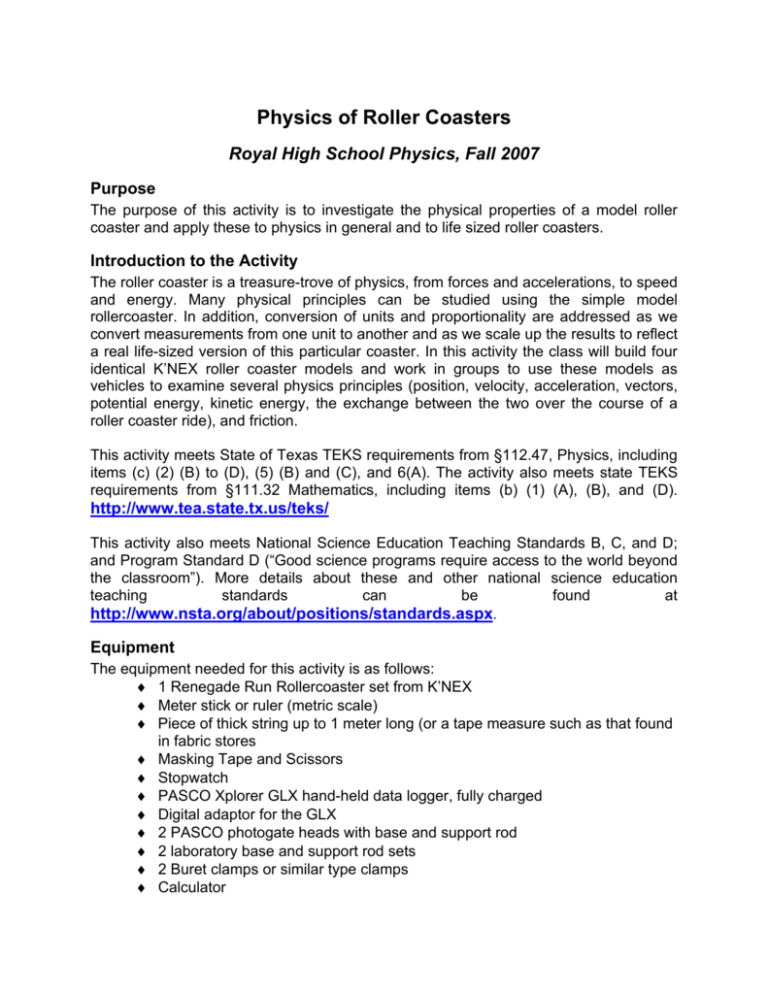
Physics of Roller Coasters Royal High School Physics, Fall 2007 Purpose The purpose of this activity is to investigate the physical properties of a model roller coaster and apply these to physics in general and to life sized roller coasters. Introduction to the Activity The roller coaster is a treasure-trove of physics, from forces and accelerations, to speed and energy. Many physical principles can be studied using the simple model rollercoaster. In addition, conversion of units and proportionality are addressed as we convert measurements from one unit to another and as we scale up the results to reflect a real life-sized version of this particular coaster. In this activity the class will build four identical K’NEX roller coaster models and work in groups to use these models as vehicles to examine several physics principles (position, velocity, acceleration, vectors, potential energy, kinetic energy, the exchange between the two over the course of a roller coaster ride), and friction. This activity meets State of Texas TEKS requirements from §112.47, Physics, including items (c) (2) (B) to (D), (5) (B) and (C), and 6(A). The activity also meets state TEKS requirements from §111.32 Mathematics, including items (b) (1) (A), (B), and (D). http://www.tea.state.tx.us/teks/ This activity also meets National Science Education Teaching Standards B, C, and D; and Program Standard D (“Good science programs require access to the world beyond the classroom”). More details about these and other national science education teaching standards can be found at http://www.nsta.org/about/positions/standards.aspx. Equipment The equipment needed for this activity is as follows: ♦ 1 Renegade Run Rollercoaster set from K’NEX ♦ Meter stick or ruler (metric scale) ♦ Piece of thick string up to 1 meter long (or a tape measure such as that found in fabric stores ♦ Masking Tape and Scissors ♦ Stopwatch ♦ PASCO Xplorer GLX hand-held data logger, fully charged ♦ Digital adaptor for the GLX ♦ 2 PASCO photogate heads with base and support rod ♦ 2 laboratory base and support rod sets ♦ 2 Buret clamps or similar type clamps ♦ Calculator ♦ Scratch Paper Procedure: Renegade Run Rollercoaster (RRR) We will look at one of the latest designs in K’NEX roller coaster technology and investigate how physics plays a central role in making the coaster as enjoyable as it is. As with any experiment, we start with a purpose statement (given above) and a procedure (these steps which work toward achieving the purpose). One of the first steps of the procedure is to make pre-determined measurements of specific physical quantities, usually dimensions and time. First, build the RRR according to instructions, and then test it to make sure it runs properly. Fix any problems that may be present, then your group will be ready to begin. One of the first things you will do is to mark off the 9 reference points that we will use to time how long the coaster passes each of 8 segments of the ride. To mark these spots, a small (1/4 to ½-inch wide) piece of masking tape attached to the strut or support of the track—not the track itself—will be affixed and will serve as reference points. These will be where you will place photogates (each team gets two) to measure how long the train takes to cross an interval. One of the things we will investigate is velocity. The difference between speed and velocity is the following: speed is an example of a scalar, which consists of a number only (the “magnitude”), while velocity is an example of a vector, which includes both magnitude and direction. Velocity and speed can be expressed in terms of instantaneous or average. Instantaneous velocity is the velocity an object has at an instant or some moment in time (or a very narrow span of time, usually one second), whereas average velocity is the velocity averaged over an extended period of time. We will investigate examples of both in this exercise. Note that this is a recommending activity to do with the K’NEX roller coaster within a classroom setting. The teachers using this are welcome to make any adjustment they need to ensure success of their students in learning Physics with the assistance of these roller coasters. The step by step procedure is as follows: • Length and height measurements o Mark off the nine points with masking tape as shown. o Measure the length of the string in cm, to the nearest tenth of a cm. o Measure the entire track using the string. If it does not equal a whole number of string lengths, mark off where the section ends by pinching that part of the string with the thumb and forefinger…measure the length in cm from the end of the string to the pinch. o Convert the measurements to cm in a manner similar to this example: if something is measured at 5 string lengths, and the length of the string is 50cm, then the length is 5X50 = 250cm. If the length measured was more than 5 strings (but less than 6), such that the section of string included in the measurement was 35cm, then the total length is 5x50+35 = 285cm. o Using this approach (or something similar that you feel comfortable with), measure the length of each interval of track and fill in the interval lengths in the table below. Do all the lengths added together equal the total length you measured as directed by the third bullet? If not, why not? (answer this in the questions section) o Make the additional measurements specified on the Data Sheet, measuring the height with respect to the tabletop on which the structure rests. (Measurements include: height of highest hill, height of secondary hill(s) if any, height of lowest point on track, total track length, number of loops (if any), loop radius for each loop…can you think of others?) Height of first hill / highest point, cm Height of lowest point on track, cm Total Track Length, cm Change in Height (highest – lowest), cm Time to complete one ride, seconds (average of 5 stop watch timings) Average ride velocity (Track Length divided by Time to complete one Ride), cm/sec Time to complete one ride, seconds (average of 5 stop watch timings—NOT INCLUDING ASCENT STAGE) Average ride velocity (Track Length divided by Time to complete one Ride, w/o ascent stage), cm/sec Number of loops 1. Loop size—measure all of them (if oval, measure the long and short dimensions and average the two), cm 2. 3. 4. Other measurements that you feel would be important can be recorded in the space provided below. • Having made all the length measurements, it is now time to make the time measurements, which we will do as follows: o With the stopwatch, take five measurements, from the starting point at the base of the first hill, until it returns to the starting point or the end-of-theline. Average these and record the average value on the Data Sheet. This is the total trip time and this value, divided by total track length, gives the average velocity over the entire ride o Do the same thing again, only this time, measure the time elapsed from the top of the hill to the bottom of the hill (not including the powered ascent up the hill). Take five measurements and average these. This gives the average velocity of the gravity-powered portion of the ride o Repeat the measurements of the first two bullets, but use the photogates instead. You will only need to make one measurement, for each of the two cases, but we recommend making three. The approach is described in the section below entitled, “Where and How to Measure Times of Travel” o Interval timings: see the section below entitled, “Where and How to Measure Times of Travel” Where and How to measure Times of Travel We will be doing a series of timings with the photogates and Xplorer GLX. All we need are two photogates, the digital adaptor, a fully charged GLX and steady hands. For some of the timings, we will affix a 10-cm long card to the train and time how long the card takes to pass through. In some cases we can mount the photogates to their stands, or the thicker, taller rods; in other cases, due to tightness of space, we will need to hold the photogates in the exact spots (one student holds a gate in each hand while the other controls the GLX. We will run the coaster several times until all the timing measurements have been collected. With each timing measurement (except for the single gate measurements) we will need to measure that same length of track, so students will need to carefully measure each length (one way to ensure consistency is to affix a small piece of masking tape on the track—placing it on the support struts / beams away from where the wheels of the train make contact—at the starting and ending points of each measured intervalÆone can place photogates at each of these marked locations) ♦ From start to finish (the entire ride…do once with stopwatches, and a second time with two photogate timers…which do you think is more accurate and why?). Two ways we can do this (for four sets of measurements) o From “A” to “I”, not including the mechanically driven ascent up the main hill (both stopwatch and timer) o From “I” to “J”: to do this with timer, hold the train so that the front is a few inches away from the bottom of the hill, then place the first photogate there. Click the start button on the GLX and gently push the train so that it (simultaneously) is caught on the ascent chain and passes through the first photogate. While it ascends the track, put aside the first photogate ♦ ♦ ♦ ♦ ♦ ♦ ♦ ♦ ♦ and put the second photogate in its place. This way, a total ride time will appear on the Digits screen when the train returns to its starting point o Do each timing with a stopwatch and photogate timers and compare the results. From the top of the hill to the start of the first loop (Point “A” to “B”) Just before the start of the first loop (single photogate with 10 cm flag at “B”) Through the first loop (“B” to “C”, hold one photogate at the start and the second at the end so as to cover the entire loop) Through the second loop (“C” to “D, same process) Interloop region “D to “E” Through the third loop (“E” to “F, same process) Through the fourth loop (“F” to “G”) From “G” to “H” and from “H” to “I” Add up all these intervals: is the result the same as the single measurement (“A” to “I”) from earlier? Why or why not? Travel times (fill in table for each measurement): Mass of Train = ____________ g = ___________ kg Interval Distance (cm) Time (s) Average Speed (cm / s) (m/s) K. E. (J) 1. Point A to I 2. Point A to B 3. Point B to C 4. Point C to D 5. Point D to E 6. Point E to F 7. Point F to G 8. Point G to H 9. Point H to I Total #2 to #9 Questions: (1.) Do all the lengths added together equal the total length you measured as directed by the third bullet? If not, why not? (2.) Why is the highest point of the ride at the very beginning? (3.) How would the ride run differently if the train were heavier? Longer? (4.) Which is more accurate for timing-the stopwatches or the photogates? Why? Calculations (5.) Calculate the potential energy at the top of the hill: P.E. = mgh (6.) Calculate the kinetic energy at the bottom of the ride (don’t forget to calculate the K.E. using the formula below for each interval and enter these values in the last column of the second table) K .E. = 1 2 mv 2 (7.) Do the final speed and / or kinetic energy at the bottom of the ride depend on the mass of the train? Why or why not? (8.) Does K.E. (from #6) = P.E. (from #5)? Why or why not? (9.) List any other forces or effects that may change the ride time on the roller coaster (or may cause K.E. ≠ P.E. if that was your answer for #8) Real-Life Extensions (10.) Let us scale our model to lift size to see what it would be like…If the K’NEX figures are 5.5 cm tall (I measured one earlier) and we scaled them up to life size with the scale of 1 foot = 1cm (each figure scales up to be 5ft. 6in., rather short, but easy to convert), what would be the height of the first hill of the RRR in life size dimensions? Height of first hill (life size) = _______ ft. = _______ m (1m = 3.281 ft.) How long is the coaster train (first measure it in cm, then scale it up to feet) = _______ cm = _______ ft (scaled up to “life size”) (11.) Using the scale factor from #9, and the maximum speed you have obtained, convert the speed to “life-sized” values of mph. We will walk you through the steps in converting… Write in your top speed here: ______ (cm/sec) Scale this to feet per second: _______ (ft/sec, 1 ft. = 1.00 cm with our scale) Change this to miles per second: _______ (mi/sec, 1mi = 5,280 ft.) Change this to miles per hour: _______ (mph, 1h = 3,600sec.) (12.) Is this a realistic value for the scaled-up speed (hint: check out the list of fastest roller coasters in the world!)? Why or why not? Hints • Use a one meter-length piece of string to measure the total length of track. Lay the string along the track, following it, until the string ends, then repeat, placing the first end where the last end finished, etc. Measure until the starting point is reached, pinch that location on the string with forefinger and thumb and measure the part of the string on the track from the leading end to where you are pinching the string. • The total measurement is simply the number of string lengths plus the final length of that final length of string. • As an alternate to save time, one can use a cloth tape measure and measure it that way. If the tape measure is only in inches, one can easily change this to cm by multiplying the measurement by 2.54 cm / in. • Use the meter stick to measure the height from the floor or table top (depending on what the coaster is resting on) to the top of the tallest hill (or whatever feature you are interested in). • Total ride time = time elapsed in seconds from the passing of the first motor or location to the return to that same motor or location • Average ride velocity = track length / time • One can also build the other coaster design shown on the back of the box. It does not look as interesting, but it may be interesting to compare similar data points from each ride. It will be left up to the student and / or teacher to define what needs to be measured, done, etc. The Fastest Roller Coasters in the World Source: http://www.coastergrotto.com/fastest-roller-coasters.jsp Info: The world’s fastest roller coaster is determined by the maximum (instantaneous) speed attained during the ride. Top 10 Fastest Steel Roller Coasters Coaster Kingda Ka Top Thrill Dragster Dodonpa Superman: The Escape Tower of Terror Steel Dragon 2000 Millennium Force Titan Goliath Furious Baco Park Six Flags Great Adventure Jackson, NJ, United States Cedar Point, Sandusky, Ohio, United States Fuji-Q Highlands, FujiYoshida-shi, Yamanashi, Japan Six Flags Magic Mountain, Valencia, California, United States Dreamworld, Coomera, Queensland, Australia Nagashima Spa Land, Nagashima, Mie, Japan Cedar Point, Sandusky, Ohio, United States Six Flags Over Texas, Arlington, Texas, United States Six Flags Magic Mountain, Valencia, California, United States PortAventura, Salou, Tarragona, Spain Speed 128 mph 120 mph 107 mph Year 2005 2003 2001 100 mph 1997 100 mph 95 mph 93 mph 85 mph 1997 2000 2000 2001 85 mph 2000 84 mph 2007 Some Roller Coaster Resources http://www.funderstanding.com/k12/coaster/ A really cool simulation that we did at the workshop that allows users to build their own virtual roller coaster and run it under different gravitational conditions. Physical parameters such as size of hills, gravity, friction, and mass can be adjusted to see how these affect the running of the coaster. http://www.delphiforfun.org/Programs/roller_coaster.htm Another interesting simulation, which appears to be more sophisticated than the first, but which requires the user to download to the local computer. http://www.glenbrook.k12.il.us/gbssci/phys/projects/frig/yepbyrji/coaster.html This web site contains all the details of the physics that go into the design of a coaster. http://www.perfectdownloads.com/games-entertainment/simulation/nolimitsrollercoaster-simulation.htm The demo that I just tried gave a very realistic simulation of a wooden roller coaster; it coasts $29 to buy the full-fledged version, but this looks like an awesome addition to ones simulation library.


